The energy penalty imposed on an HVAC system by a leaking return duct can reduce the efficiency of a system by as much as 40% during extreme weather conditions. What is staggering is that unless you measure to discover it, this defect is invisible to you and your customer. Add this quick test to your service and sales offerings and become an HVAC rockstar to your customers.
The idea that offering your customer high efficiency equipment as the one and only silver bullet for energy savings is a false idea. More importantly, as your competition learns to test and diagnose the performance of their systems, you will fall farther behind industry advancements.
Savvy HVAC professionals are learning to pull their heads out of the box and look to the air distribution system to differentiate themselves from their competition and gain the admiration of the customers for years to come.
Return Duct Energy Loss Scenario
A return duct joint is leaking. It may be due to age, poor installation, or the cable guy. Return ducts are on the negative pressure side of the fan, so any leak pulls energy zapping hot or cold air into the duct system whenever the fan is running.
If the return duct is in the attic, crawlspace, or basement, it will pull unconditioned outside air into the system. Even if the duct is between floors, it can pull air from a hot or cold attic or from outside if there is a connection between the two spaces. In winter or summer months, attics are often 30 degrees colder or hotter than indoors making a recipe for an invisible energy penalty.
Let’s say a return duct is pulling 300 CFM from between the floors in a two-story home. At first look you believe it’s harmless because the duct is pulling conditioned air from between the floors, right?
However, let’s also say the upstairs is 800 sq.ft. and the area between the ceiling and the floor is 1.5 feet.
The area between the floors is 800 feet times 1.5 feet or 1200 cubic feet.
In reality, the 300 CFM return leak sucks the conditioned air out of that space in only 4 minutes (1200 cubic feet divided by 300 CFM = 4 minutes) The conditioned air in that space in soon replaced with hot or cold air the fan pulls in from the attic or from outside.
The replacement air is often 30F warmer or colder than the air in the home. So the argument that the duct is in conditioned space only holds up for a few minutes.
As I look out my office window this morning and see Lake Erie frozen as far as I can see, we’ll stick with a heating example today. Using the scenario above, we have a 300 CFM return leak, which is all too common. We also have a 30F temperature difference between inside and outside.
To calculate the impact of this return duct leak use the sensible BTU formula which is the CFM of return duct leak, times the temperature difference of 30 degrees times the sensible BTU multiplier of 1.08. This formula reveals the BTUs being pulled into the system is 9,720 BTUH.
Let’s say the rated furnace output is 54,000 BTU (60,000 Output x 90 AFUE). Divide the 9,720 BTU resulting from duct leakage by the 54,000 BTU output of the furnace to discover 18% of the heating capacity of the furnace is being impacted by the return duct leak.
Now for the final step; subtract the 18% loss in efficiency from the return duct leak from the 90% furnace efficiency to find the system efficiency has dropped from 90% to 72%.
The Solution
Now go and present your findings to the customer. First, be sure to place all the blame on the cable guy and make sure you are the rockstar in the story because you measured the performance of the system, discovered the problem, and can provide the solution. Pat yourself on the back. Taking credit is an important element in your success story. Be sure to remain humble in moments of greatness such as these.
Be prepared to quote the repair at a price that is worth the value of the repair. Find a price that delights both you and your customer. This would be a price that you and your company are well rewarded for performing the testing, diagnosing the problem, and making the repair.
The price can also delight your customer because they feel it is worth the 18% increase in efficiency when their system is operating properly. Just think how much more your customer would pay for a 90% efficient system compared to a 72% efficient system. You can portray the value by discussing a percent reduction in their annual heating or cooling costs to help them see the value of the repair.
The Testing
From the scenario above you can see the testing needed to diagnose the problem requires you to measure temperatures and the airflow through the return duct leak. The temperature difference is measured between the return air temperature from the home and the return air pulled from the attic or outside. This requires a simple dry bulb thermometer in heating mode.
The CFM of return duct leakage is measured in two steps. First measure the fan total external static pressure, using that pressure and the fan speed setting plot fan airflow on the manufacturer’s fan performance table. Next you add together the total airflow of all of the return grilles in the system. Subtract the total of all the return grilles from the fan airflow. The difference is the CFM of live return duct leakage.
Follow the math described in the scenario in this article to calculate the return duct energy penalty in the systems you service and sell to add to your skills and abilities as you strengthen your profession.
About the Author
Rob 'Doc' Falke
President
Rob “Doc” Falke serves the industry as president of National Comfort Institute an HVAC-based training company and membership organization. If you're an HVAC contractor or technician interested in a building pressure measurement procedure, contact Doc at [email protected] or call him at 800-633-7058. Go to NCI’s website at NationalComfortInstitute.com for free information, articles and downloads.


